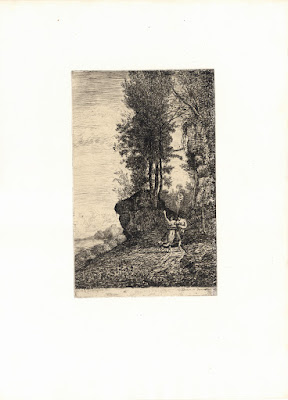Pieter
de Jode II (aka Pieter de Iode; Petrus iunior de Jode; Pieter de Jonge Jode)
(1606–70/74)
“Portrait of Jan Snellincx” or “Ioannes Snellincx”, 1630 (published
in 1645), after Anthony
van Dyck (1599–1641), from the series “Icones Principum Virorum.”
Etching and engraving (the BM advise that there are “traces
of oxidisation on the plate”) on laid paper.
Size: (sheet) 26.3 x 17.9 cm; (plate) 23.4 x 15.3 cm; (image
borderline) 20.9 x 14.9 cm
Lettered below the image borderline: (centre) "IOANNES
SNELLINCX / PICTOR HVMANARVM FIGVRANRVM ANTVERPIÆ. / IN AVLÆIS ET TAPETIBVS."
Inscribed below the image borderline: (left) "Ant. van Dyck
pinxit. / Pet. de Iode Sculp."; (right) "Cum priuilegio."
State vii (of vii with the initials of Gillis Hendricx
burnished)
Hollstein 157 (Jode); Mauquoy-Hendrickx 1991 37.VII; New Hollstein
(Dutch & Flemish) 9 (Van Dyck; copy); New Hollstein (Dutch & Flemish)
91.VII (Van Dyck)
The British Museum offers the following description of this print:
“Portrait of Jan Snellincx, half-length, turned slightly to the
right but facing the left; with moustache and goatee, wearing a scullcap, a
heavily draped doublet and a sash around his waist, his left hand resting on
his abdomen, clouds in the background; seventh state with the initials of
Gillis Hendricx burnished; after Anthony van Dyck Etching and engraving with
traces of oxidisation on the plate” (http://www.britishmuseum.org/research/collection_online/collection_object_details.aspx?objectId=1427290&partId=1&searchText=R,1b.5.&page=1)
Condition: richly inked, crisp and beautifully printed impression
with good margins of approximately 1.5 cm in excellent condition for its age and
only a tiny closed tear at the upper-right corner. There are remnants of
mounting and previous collector’s notes verso.
I am selling this museum-quality print for the total cost of AU$206
(currently US$158.28/EUR138.62/GBP122.10 at the time of posting this listing)
including postage and handling to anywhere in the world.
If you are interested in purchasing this absolutely beautiful
etching (with engraving), please contact me (oz_jim@printsandprinciples.com)
and I will send you a PayPal invoice to make the payment easy.
This portrait of the Flemish painter, Jan Snellincx (1544–1638), is
arguably best remembered for his battle scenes and, as the Fritzwilliam Museum
points out, the “rising smoke in the background” of this portrait is perhaps an
allusion to such battle scenes (http://www.fitzmuseum.cam.ac.uk/gallery/vandyck/biographies/jansnellinck.1.html).
Although the print was inscribed by Pieter de Jode II, to my eyes the
original compositional arrangement crafted by Van Dyck—the preliminary drawing
for this print is now in the Duke of Devonshire’s collection at Chatsworth—is
what makes this print so engaging to contemplate. From my reading of the
composition, I see Snellincx responding jovially to someone, or some incident, lying
outside of the borderline of the image and I feel drawn into trying to
determine what he is thinking.
Beyond this marvellous portrait, Van Dyck had a much grander
vision. According to the curator of the British Museum, he envisaged creating:
“… a print publication containing portraits of the most prominent
men during his lifetime, divided into three categories: princes, politicians
and soldiers (16), statesmen and scholars (12), artists and art connoisseurs
(52). The initial idea could have been that Van Dyck would etch the faces (a
process possibly learnt from Vorsterman) while others would finish the plates in
engraving. Designs were needed for the plates and several drawings and oil
sketches (grisailles, sometimes in different versions) have survived. Van Dyck
only etched 17 plates himself, while he commissioned others to complete the
set, overseen by Lucas Vorsterman I (especially after Van Dyck settled in
England in the Spring of 1632). Although this project was started by Van Dyck
around 1630, he never saw it completed.” (http://www.britishmuseum.org/research/collection_online/collection_object_details.aspx?objectId=1422752&partId=1&people=101862&peoA=101862-1-6&page=1)






















































